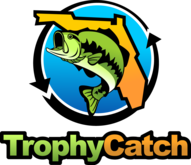 Many of our readers already know that in 2012 the Florida Fish and Wildlife Conservation Commission (FWC) launched TrophyCatch, a new incentive-based conservation program designed for anglers who catch-and-release largemouth bass heavier than eight pounds, in Florida. Goals of this new initiative include providing verified catch data about trophy bass to guide conservation-management strategies, encouraging live release, and recognizing and rewarding anglers for participating in this citizen-science effort. This will ultimately increase trophy bass fishing opportunities and add to our knowledge of these valued fish.
Check out TrophyCatchFlorida.com now to register for free for the 3rd year’s boat drawing and to learn how to submit your catch, so the data can contribute to the future of bass fishing in Florida and you can earn great rewards from our sponsors. While there, check out the Gallery of Catches, or do a search to find where trophy bass have been caught near you. Meanwhile, be sure to “like” us on FaceBook.com/TrophyCatchFlorida to keep up with the latest developments.
The first year of TrophyCatch (Oct. 1, 2012 - Sep. 30, 2013) wrapped up a year ago. Here were some highlights from TrophyCatch year one:
■ 1,941 registrants.
■ Almost 200 verified largemouth bass Lunker, Trophy, and Hall of Fame Club winners.
|
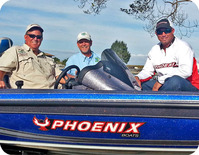 |
|
■ Phoenix bass boat powered by Mercury awarded to random-drawing finalist Frank Ay from N Lauderdale (on left in photo). |
■ $10,000 from Experience Kissimmee awarded to Peter Perez for the largest bass caught in Osceola County (second from right). |
|
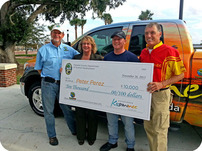 |
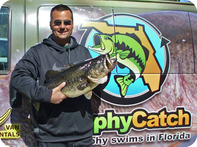 |
|
■ TrophyCatch Champion Ring awarded to Bob Williams from Alloway, NJ for the largest entered TrophyCatch bass, 13 lbs., 14 oz. |
■ Over $70,000 total in prizes awarded.
As TrophyCatch continued into its second year, FWC announced simplified submission requirements and increased prizes. The largest change in submitting a bass is that only one photo, of the
entire fish on a scale with the weight clearly legible, is required.
However, photos of the length, girth, angler holding fish, and release
are encouraged. Phoenix and Mercury again provided a bass boat package for year two, this time including a Power-Pole anchor. The big winners of this year's major prizes haven't been announced at time of writing, but will be included in the next issue. In the meantime, here are the latest TrophyCatch statistics as of September 2014:
■ Over 8,000 total registrants.
■ Nearly 1,000 verified largemouth bass Lunker, Trophy, and Hall of Fame Club winners.
■ More than $102,000 in prizes awarded during Year 2.
Stay tuned for the 2013-14 winners, and for exciting prizing updates for the new 2014-15 TrophyCatch year! For more information, and to register or submit fish, visit TrophyCatchFlorida.com.
Back to top
 Have you checked out the Florida Fish and Wildlife Conservation Commission's (FWC) fishing blog yet? The Freshwater Fishing Blog launched last year and is hosted by Florida Sportsman. Our intent in this blog is to provide you with a stream of useful information to enhance your enjoyment and understanding of Florida’s diverse and exceptional freshwater fishing opportunities.
About the authors: Florida’s Freshwater Fishing Blog is brought to you by FWC. Our staff are dedicated to managing your freshwater fish resources for their long-term well-being and the benefit of people like you. Reach them at Freshwater.Fisheries@MyFWC.com.
John Cimbaro works in the southern part of the state. He produces the Florida Freshwater Angler newsletter and will provide input on local fishing conditions and events.
KP Clements, the TrophyCatch Program Coordinator, will generate exciting updates on this angler recognition reward program.
Dustin Everitt works in central Florida and will let you know about conservation projects and fishing conditions there.
Justin Hill, the outreach coordinator for freshwater fisheries research, will write about the science behind fisheries management.
Rick Stout, Florida Bass Conservation Center Coordinator will inform you of stocking programs and their effects.
Bob Wattendorf, a fisheries scientist with over 35 years experience in Florida is author of the Fish Busters’ Bulletins and also serves on the boards of the Florida Outdoor Writers Association and Get Outdoors Florida. He will keep you informed about outreach activities and happenings that affect your fishing.
Along with guest writers, we’re here to provide answers about everything and anything to do with freshwater fisheries management, research and enjoyment in Florida!
Back to top
|
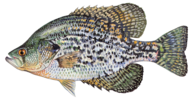 Size: This fish averages just under a pound; the state record is currently 3.83 pounds. The Big Catch minimum qualifying sizes are 14” or 2.0 pounds (see BigCatchFlorida.com).
Identification: The black crappie’s distinct black-and-white patterning, symmetrical back (dorsal) and belly (anal) fins and flat panfish shape make it easy to identify.
Similar species: The only other species that might cause some confusion is the exotic jaguar guapote found in south Florida, which has a divided lateral line and sharp teeth that distinguish it from our native black crappie.
Angling qualities: Most Florida anglers are quite familiar with the “speckled perch” or “speck”. This fish follows on the heels of the largemouth bass for popularity in the fresh waters of our state. The crappie is not quite as easily found or as widespread as the bass, however. Specks do best in larger lakes, particularly if deep water and cover—especially brush—are present, but is less common within canals. Crappie make ideal cane pole or light tackle targets. Missouri minnows are the bait of choice. Lure anglers usually stick with small marabou or curlytail jigs, with white, yellow and black being good starting colors. Beetle spins of various colors also work well. Fly anglers can do well with small streamers, but will need to use a sinking line to get down to the fish. Set the hook gently, as the soft mouth (which has resulted in the nickname “papermouth”) can result in missed strikes. This fish fights well and performs even better on the table. A key to success is to fish at different depths and keep moving until you find a school. Once located, large numbers of “specks” can often be caught within a short period of time.
Back to top
|
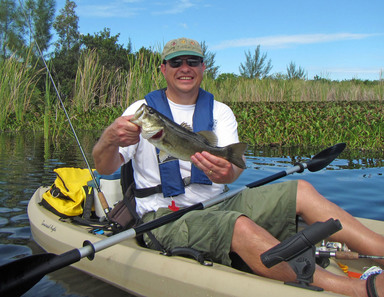 |
Last
year my wife and I finally got a pair of kayaks. I’d had a chance to
paddle a friend’s kayak once or twice before, but never had a kayak of
my own to spend some serious time with. Even after a couple decades of
small-craft boating, I was quite impressed with the portability and
versatility of these craft. Here’s some of what I’ve learned in the past
year.
Cost: If
you’ve been thinking of taking the plunge with a kayak, there’s never
been a better time. Kayaks have become very popular in recent years,
meaning that more manufacturers are making them and prices for an
entry-level kayak are even lower than they used to be. Standard kayak
models start at a low of about $200 on sale, but you’ll want to spend
more for a fishing kayak that comes complete with rod holders and other
angling amenities—expect to pay from $250 on up on sale. You’ll also be
buying a double-bladed kayak paddle, which will run you $50-100 or more.
Most kayaks don’t include a padded seat, and you’ll probably want one;
add another $50-75. Yes, the tab is adding up pretty quickly, but you’re
still well under what the cheapest johnboat and trolling motor will
cost you. Smaller accessories, such as a light anchor and—of course!—a
life vest, you may own if you’re already a boater.
A
kayak is a very personal purchase, and you should buy from a vendor
that will allow an exchange if you don’t like the way the craft fits you
or how it performs in the water. Otherwise, some kayak shops are near
water and will let you try before you buy. Keep in mind that you’ll need
a way to transport your kayak, if you can’t just throw your new
purchase in the pickup and head for the lake. A good roof rack setup or
trailer will cost you more than your kayak will, but a kayak is still
one of the most economical boating options out there. (See Issue 45 at
www.bit.ly/FFAngler for more information about roof racks.)
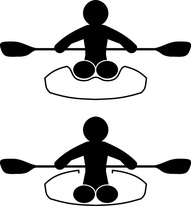 Sit-on-top versus sit-inside: There are two basic kayak types. A sit-on-top kayak is a sealed hollow shell with molded seating on top to accommodate the paddler. It’s easy to get in or out of, a major plus if you plan to kayak-and-wade. The kayaker sits above the waterline, which increases visibility and casting distance, but leaves the kayaker exposed to waves and splashing. Storage space is mostly open to the elements, but is easily accessible. However, there will probably also be one or two watertight hatches that allow dry storage inside the kayak shell. Note the size and location of the hatch openings, as these will limit what you’ll be able to fit inside and whether you’ll be able to reach them from the kayak seat. Water that splashes into the kayak drains out through scupper holes, which can be plugged to prevent water ingress, if you’ll be on calm water.
A sit-inside kayak is self-descriptive: the paddler sits inside a cutout in the open hull. Add an apron, and the paddler is pretty well protected below the waist from waves and water. The angler is sitting at the waterline, and the lower center of gravity may provide a more stable ride but slightly limited visibility and casting distance. The open hull provides plenty of fairly dry inside storage in front of and behind the kayaker. However, this internal storage is not as easily accessible, and entering and exiting the kayak is not nearly as easy. Generally, the sit-inside design is a good choice for river or ocean kayaking but will also serve in quieter ponds and lakes. However, many stillwater anglers prefer the in-and-out convenience offered by the sit-on-top design.
Fishing kayaks: The simplest thing that defines a “fishing kayak” is the presence of rod holders. A fishing kayak will also usually be wider than standard kayaks—around 30” or so—and therefore more stable. It may have extra storage features, like molded in tackle trays or even a baitwell. Note that you can add after-market rod holders to most kayaks, but you’re better off starting with a fishing kayak, mainly for the added stability. A wider kayak won’t cut through the water as quickly as a standard model, but you’ll be able to cast, set the hook, and land frisky fish without feeling like you’re about to take a spill at any moment. I was really surprised at how stable my kayak is—definitely less tippy than most canoes I’ve used.
Length: Length is important. A longer kayak will travel faster and more efficiently (and have more storage space), but weigh more to load and carry—especially important if you’re cartopping or portaging. Twelve to thirteen feet is a popular range for saltwater anglers, and will provide a roomy and stable freshwater fishing platform too. However, if portability is important, look hard at kayaks ten feet or less in length. My ten-footer is a lightweight at exactly fifty pounds, but I’d still swear it’s half full of water when I hoist it back onto my roof racks at the end of a long paddling day. The weight is much easier to handle if you’re securing your craft to something below shoulder level, like a pickup bed or trailer. A kayak cart can also be a big help moving your boat from car to water (more on that later). Long story short, consider weight an important factor based on how you’re transporting your kayak.
|
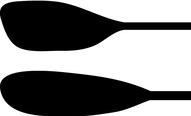 Paddles: Kayak paddles are double bladed, unlike rowboat oars or canoe paddles. This makes the kayak an extremely efficient craft, because you propel it with both the forward and what otherwise would be the “back” stroke. Paddles come in specific shaft lengths, which you choose based on the width of your kayak and your height. The wider your kayak and the taller you are, the longer paddle shaft you will need. Kayak and paddle manufacturers provide tables for making your best choice. Paddle blades also vary. A long narrow blade works well for propelling a kayak nonstop over long distances, while a short broad blade works well for tight maneuvering along brushy shorelines and the stop-and-go travel a kayak angler will likely be making. In Florida’s lakes and ponds, most anglers should stick with a broad blade. As a side note, be aware that some fishing kayaks are equipped with various ingenious pedal-and-propellor systems that make propulsion a lot easier and leave your hands free for fishing. These are nice, but significantly more expensive, and are generally restricted to longer kayaks. Some kayaks can be outfitted with a trolling motor; note that you will have to register the kayak if you go this route, and will need room for a 12-volt battery.
|
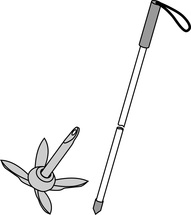 Accessories: Your number one accessory is your life vest, or PFD (personal flotation device). I prefer an inflatable PFD for its coolness and light weight, although many kayakers will tell you that you’re going to tip over (and activate the CO2 cylinder) sooner or later. Your risk is less in stillwater ponds and lakes; however, I’m willing to live with that possibility, especially during the summer heat. Make sure you are also complying with all other boating safety requirements (MyFWC.com/boating/safety-education). Another “must have” accessory will be a dry storage bag for keeping your phone, electronic car keys, camera and other sensitive gear safe from the elements.
If you are going to have to carry your kayak any distance between your parking spot and the water, consider buying a wheeled kayak carrier. These handy little carts strap onto the bottom of your kayak, allowing you to roll your craft to the water. An advantage of these is that you can load all your equipment into the kayak as well and make a single quick trip, rather than going back and forth to your vehicle for paddle, anchor, rods, etc. or having to try to carry them all at once. Strapping the wheels in place near the kayak’s center of gravity will provide a balanced and effortless walk to the water’s edge. Some kayak manufacturers offer carts that will fit right into their kayaks’ scupper holes, eliminating the need for straps.
One of the (few) annoying things about fishing from a lightweight kayak is that it is easily pushed around by wind or waves, so you’ll want a lightweight folding anchor to help you stay put. An anchor works best in deeper water or when you’ll be staying put for a little while, such as when fishing bait. If you use the anchor a lot, you’ll want an anchor trolley that allows you to position the anchor line fore or aft, depending on wind or current and how you want to position your craft. For frequent moving and anchoring—which I’ve found to be the norm for lure fishing—a stakeout pole is much more convenient. This is simply a pole pushed into the lake bottom to anchor the kayak. The pole can be inserted through a scupper hole, or attached to the kayak with a short rope and snap clip. Many anglers prefer a stakeout pole over an anchor, because there’s less chance of tangling with a scrappy fish. You can buy a commercial stakeout pole, or make your own out of PVC pipe or any other sturdy pole such as an old golf club with the head removed. Use is obviously limited to fairly shallow water, depending on the length of the stakeout pole.
There’s a host of other accessories available: extra or specialized rod holders, rod and paddle tethers, depth finder and camera mounts, special kayak tackle holders, baitwells, and more. Kayakers (and kayak manufacturers) seem to be a particularly inventive lot! Customizing your kayak for your comfort and specific fishing needs can not only put more fish in the boat, but also be a satisfying end in itself.
Care and feeding: One of the great things about kayaks (especially if you’ve ever scrubbed down a large boat after a saltwater fishing trip) is that they require almost no maintenance. Just hose your kayak off after a muddy or saltwater fishing trip, stow it out of direct sunlight, and that’s about it! With minimal care, a kayak will last for years.
Fishing from a kayak: Okay—you already know how to fish. But fishing from a kayak is different, even from fishing in a small canoe or johnboat. While fishing kayaks are usually very stable, you must keep your balance in mind at all times—when leaning over to unhook a snagged lure, setting the hook or netting a fish. While fishing kayaks are roomier than their standard-sized brethren, space is still at a premium. Many of your kayak customizations, if you make any, will probably involve gear storage. I don’t like much in my way while kayak fishing, and keep minimal gear (like hooks, plastic worms, and pliers) in a small tackle box or tackle bag in front of me. The rest of my tackle, plus raingear, sunblock, etc. are in a larger waterproof duffle bag stowed behind my seat. I don’t need to move to release a fish, tie on a new hook, or change out my worm. If I need something more, I can reach back to grab the duffel bag, or hop out in shallow water to grab it. Water or sports drinks—a must for the Florida kayaker—go under the bungee straps in the front or rear of my kayak, depending on the rest of my loadout and available space. My kayak actually has a cup holder right in front of the seat, and a sports drink goes there right away when I launch.
I’ll work a shoreline or deeper water the way I normally would from any small boat. However, since I’m sitting low my casting distance and visibility are more limited, so I sometimes have to work closer. Thankfully, a stealthy kayak is ideal for this. I can often paddle along just casting as I go, but sometimes wind or wave action requires me to anchor my stakeout pole at every stop. A stakeout pole or anchor also help when you hook a bigger fish. You’ll be able to land most fish with ease, but I’ve had hard-fighting fish as small as four pounds take me for a brisk “sleigh ride”. This can actually be fun in open water, but if you’re casting anywhere near docks or submerged brush you’ll want to anchor yourself if you hope to have any control when “the big one” hits. And when he does, a kayak will put you closer to the action than anything else except wading.
The kayak advantage: Besides simply being fun and exciting to fish from, kayaks have one more major advantage: portability. Anywhere you can stand, you can launch. Since getting my kayak, I’ve been amazed at the world of new fishing opportunities that have opened up for me. Some of these new opportunities have turned up at my “old” fishing holes, where I can now launch a boat off a 60-degree canal bank, or where a sliver of public shoreline lets me get into an otherwise-inaccessible lake. I recently fished a narrow canal that would have been too brushy even for a canoe. There’s something eminently satisfying about catching a big fish that you know was out of reach of anyone else—except a fellow kayaker.
For more information: Numerous books specifically on kayak fishing are now available. Online, general information about getting started in kayaking can be found at smart-start-kayaking.com. Numerous videos on everything from getting in and out of your kayak without tipping over to paddling and fishing from it can be found by searching at YouTube.com.
Back to top
|
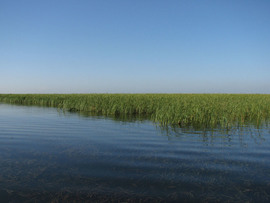 Size: 730 square miles.
Location: Palm Beach, Martin, Glades, Okeechobee, and Hendry counties.
Description: Lake Okeechobee is Florida's largest lake and the second largest
body of fresh water in the contiguous United States. The word Okeechobee comes
from the Seminole Indian language "Oki" (water) and "Chubi"
(big) and means "big water." These early Floridians chose the name
well. Vast surface area (730 square miles), shallowness (averaging only nine
feet deep) and enormous habitat diversity makes the ecosystem unique on the
North American continent. The lake is a multiple-use resource, which supports
valuable commercial and sport fisheries, provides flood control, and acts as a
reservoir for potable and irrigation water for much of south Florida.
Lake Okeechobee is located on the south-central portion of the Florida
peninsula about an hour and a half south of Orlando. Major natural tributaries
to the lake are Fisheating Creek, Taylor Creek and the Kissimmee River. Sheet
outflow occurred historically across the entire southern rim into the
Everglades. Lake Okeechobee is now connected to the Atlantic Ocean through the
St. Lucie Canal as well as the Gulf of Mexico through the Caloosahatchee
River.
Aquatic plant communities benefit fish by providing spawning habitat, serving
as refuge areas from the environment and predators, and support an intricate
food web by providing nutrients for invertebrates and herbivorous fishes, which
serve as forage. Changes in water level and differences in plant community
structural complexity and water quality within vegetation communities exert the
greatest effect on fish distribution in the littoral zone of Lake Okeechobee.
Historically, bulrush has yielded the highest average numbers for total fish
and game fish in block net sampling conducted on Lake Okeechobee. Importance of
bulrush as habitat for adult game fishes has long been recognized by fisheries
biologists, and bulrush is frequently planted during lake restoration and
habitat enhancement projects.
Submersed vegetation types [i.e. eelgrass, hydrilla, Illinois pondweed (commonly known as peppergrass)] provide important habitat for forage fish, such as minnows, shiners, and small bream. These submersed plant communities when combined with the littoral emergent plant communities, such as bulrush, spikerush, emergent grasses, and cattail can produce great fishing in Okeechobee, especially when they create a mosaic of habitat.
The hurricanes on Lake Okeechobee during 2004 (particularly Hurricanes Frances
and Jeanne) caused brief high water level surges to over 18 feet and, together
with high winds, had a devastating effect on many plant communities. From the
constant beating of high wind and waves, thousands of acres of plants such as
bulrush, peppergrass, eelgrass and hydrilla were uprooted or broken off. Plants
near the bottom or in protected areas were subjected to die-off from little or
no sunlight reaching them as a result of highly turbid water over a long period
of time.
The drought starting in 2006 that struck much of the state of Florida, lowered
the lake level to an all-time record of 8.82 ft. msl (July 2007). Periods of
drought have occurred on Lake Okeechobee about every ten years. The drought
actually helped by allowing most of the emergent vegetation that was lost to be
replaced by new plants. After Tropical Storm Fay (August 2008), when water
levels rose quickly (luckily not too fast to damage new vegetation), thousands
of acres of new bulrush, spikerush and other desirable emergent plants covered
old established areas as well as many new areas where vegetation had not been
in recent memory. Submerged vegetation such as peppergrass, eelgrass and
hydrilla also returned. With the return of vegetation, many aquatic insect
populations also increased, providing a food source for bait fish (such as
minnows and shad). With this renewed food source and resurgence in vegetative
habitat, many fish have had large spawns since Tropical Storm Fay, causing
fisherman to see an increase of many game species.
Recent creel surveys on Okeechobee have shown near record
success rates for anglers fishing for largemouth bass, black crappie, bluegill
and redear sunfish. Anglers have been
catching many bass over eight pounds and some have even reported catching bass
over twelve pounds. Bass fishing is good
year round in Okeechobee, but is the best during the winter months from
December through early spring in April.
You can still catch plenty of bass outside of this window, but this is
when they are typically spawning in Lake O.
Crappie fishing is best during January through March. Small jigs or minnows are best and moving
around until you locate a school is the best method. The bluegill and redear sunfish usually begin
spawning in late March and will continue through the beginning of June. These fish provide great fun for all and are
also good to eat!
Back to top
|
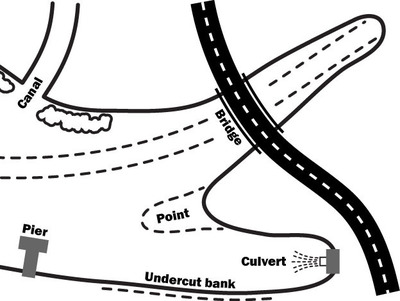 |
“Living on
the edge” is something you might say about someone who likes taking
chances or enjoys living dangerously. And wild animals, including fish,
live dangerously almost every minute of their lives. But many
animals—especially fish—live “on the edge” in another way, too.
One
of the better examples of this that I can recall was fishing Okeeheelee
Fish Management Area in Palm Beach County. I would troll plastic worms
behind my little 12-foot johnboat and electric motor. As soon as I’d get
that distinctive tap-tap-tap, I’d drop my rod tip, cut the motor, and
set the hook as soon as the slack was taken up. The fish weren’t big but
action was always plentiful. And there was one spot where I always knew
I’d get a strike: a submerged roadbed from the lake’s shell pit days.
As soon as I marked the depression on my depth finder, I’d prepare for a
strike as my worm crossed the road. I was seldom disappointed.
Whether
it’s a submerged roadbed, sudden drop-off, weed edge, or underwater
fenceline, fish love to hang out around edges. There are several good
reasons for this. First, an edge is often a meeting of two habitat
types, such as open lake connected to a shallow marsh. Such a habitat
edge is called an ecotone, and for a bass that can mean twice as much
chance of finding forage wandering from one habitat type or the other.
An edge like a shoreline bulrush stand can provide cover, too, for both
an ambush predator like a bass and a forage species like a bluegill. A
drop-off can provide concealing shade during part of the day. A
submerged roadbed, fenceline or natural channel might be used as a
travel corridor. Other boundaries the savvy angler will look for can
include the shoreline itself, spikerush stands or lily pad fields,
hydrilla mats, docks and piers, bridge pilings, underwater humps, canal
intersections, water control structures and culverts, undercut banks or
even a single fallen tree or large rock.
Edges aren’t
always created by physical structure. The edge of a current flow or the
border between muddy water and clear can also draw fish. The calmer
edges of a culvert outflow is also a great place to toss your lure. Fish
under a bridge will often stay within its shadow, and snook at night
love to hang out at the very perimeter of a light shining on the water.
All of these different types of borders will attract and hold fish, for a
variety of reasons. So if you feel like your life has been a little
boring lately, think like a fish and try fishing “on the edge”!
Back to top
This newsletter got its start as a regional freshwater fishing periodical, "The City Fisher", in heavily urbanized southeast Florida. Back issues are available. To contact the "Florida Freshwater Angler", email John Cimbaro.
|